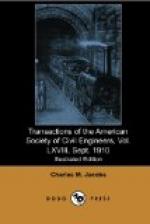Six Cameron pumps, varying in size from
7 by 6 by 13 in. to 10 by 8
by 16 in. The first dimension
referring to the diameter of the steam
cylinder, the second to that
of the water, and the third to the
stroke.
Five Rand sheeting drivers.
Two Ransome 3/4-cu. yd. concrete mixers,
mounted on frame, with
kerosene driving engine.
Drills drawn from pit plant as required.
3.—Pit-Excavating Plant.
One guy derrick, 50-ft. mast and 45-ft.
boom, operated by a Lambert
two-drum and swing-gear hoisting
engine, with Lambert 25-h.p.
upright boiler.
Three stiff-leg derricks, similar to those
used on the retaining wall
work.
Three Bucyrus, 70-ton steam shovels with 31/2-cu. yd. dippers.
One traveling derrick, built with an A-frame
of 12 by 12-in. timbers,
15-ft. mast, and 25-ft. boom;
the traveler carried an engine and
boiler similar to those used
on the stiff-leg derricks, and was
used on the Seventh and Eighth
Avenue sewers, as well as in the pit.
Ten Rand-Ingersoll rock drills, Nos. 1, 31/4, and 4.
One Reliance stone crusher (nominal capacity
17 tons of crushed stone
per hour) belt-driven by 50-h.p.
engine.
4.—Transportation Plant.
During the whole of the first period the
transportation plant
consisted of two-horse trucks
and snatch teams as needed. The number
varied greatly from 25 at
the beginning and end of the period to an
average of 135 from August
1st to December 1st, 1904, about 10% of
the total number of teams
being used as snatch teams.
5.—Dock Plant.
The only machinery used on the dock during
the horse-and-truck period
was one stiff-leg derrick
similar in size and operation to those
described under the head of
retaining-wall plant.
The plant described above does not represent that which was used during the whole of the horse-and-truck period, but what had accumulated at the end of it. The power-generating plant might almost have been omitted from this period, as the first compressor did not begin running until February, 1905. Previous to that time, the power for drilling, pumping, driving, sheeting, etc., was steam furnished by the boilers which subsequently drove the compressors, these being brought on the ground and fired as occasion required.
Train-Disposal Period, Beginning May 22d, 1905.
At the beginning of this period there had been excavated 242,800 cu. yd. of earth and 22,800 cu. yd. of rock, of the total excavation of 803,500 cu. yd. of earth and 804,000 cu. yd. of rock included in the principal contract, leaving to be excavated under that contract 560,000 cu. yd. of earth and 781,200 cu. yd. of rock, and an additional contract had been let to the New York Contracting Company for the terminal power station, which increased the earth by 16,500 and the rock by 15,500 cu. yd. During the year following, contracts for the east and west portions and the sub-structures were let, which brought the total to be excavated, after the beginning of the train-disposal period, up to 681,000 cu. yd. of earth and 1,494,000 cu. yd. of rock.




